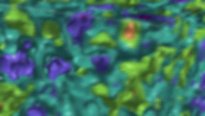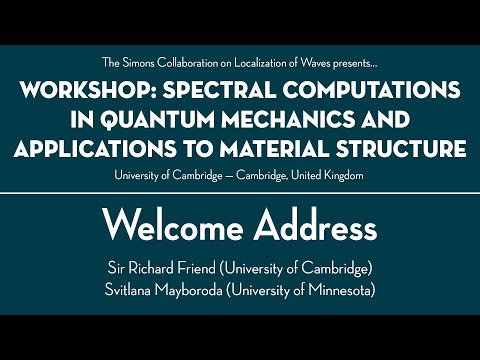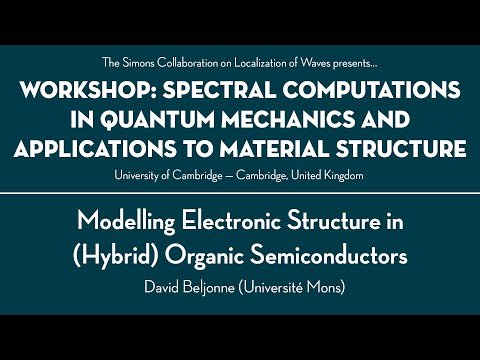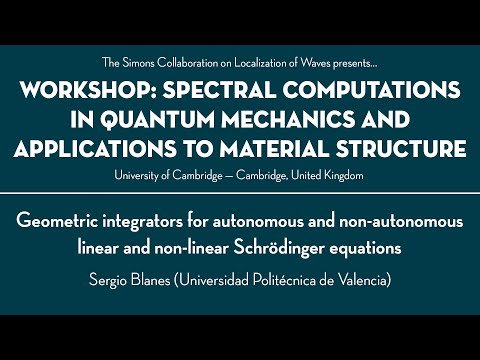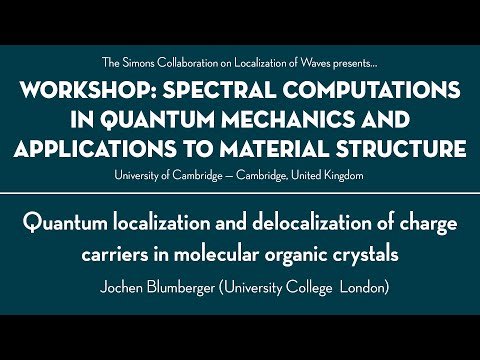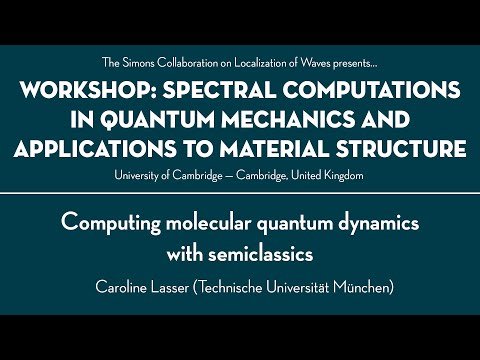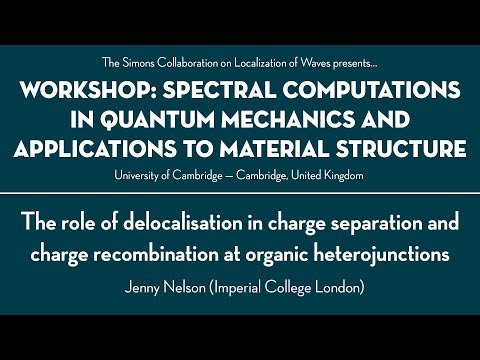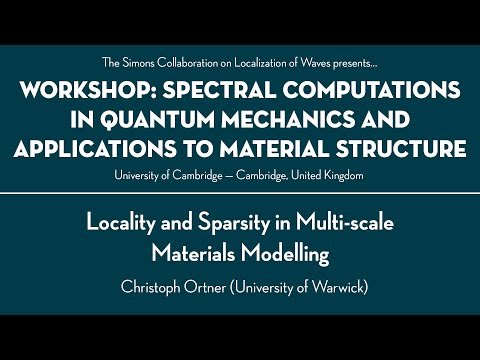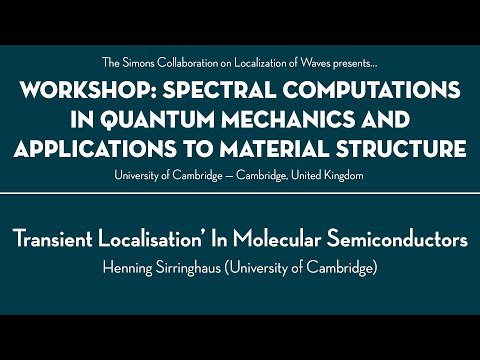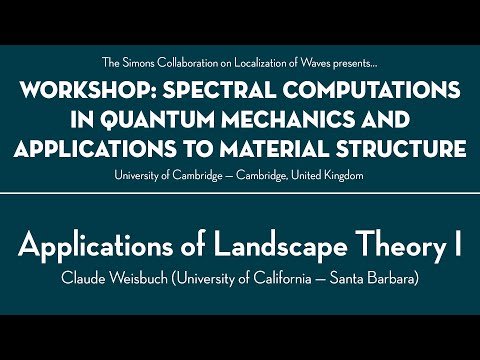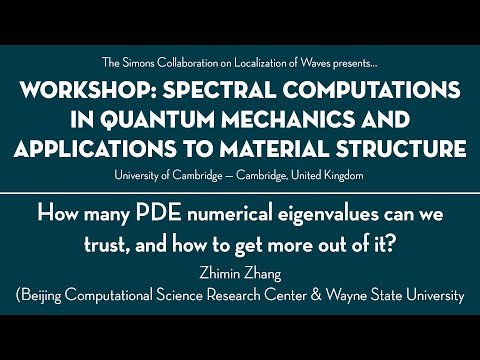Workshop: Spectral Computations In Quantum Mechanics and Applications to Material Structure
Department of Physics, Maxwell Centre Cambridge, UK — October 23-27, 2019
Organizers: Douglas Arnold, Sir Richard Friend, and Arieh Isereles
The purpose of this meeting is to introduce newcomers to the Landscape Theory and its Applications and dive deeply into how it manifests in Molecular Semiconductors, Organic Semiconductors, and the Electronic Structure of Nitride.
Conference Information
+
Schedule, Abstracts, Presentation Slides, and Video Recordings
UK Simons Meetings — October 23, 2019
08:30 - 09:00: Coffee and Tea / Posters are put up
09:00 - 09:15: Welcome — Sir Richard Friend, University of Cambridge/Svitlana Mayboroda, University of Minnesota
09:15 - 10:00: Introduction to Landscape Theory — Marcel Filoche, Ecole Polytechnique
- Abstract: The Localization Landscape (LL) is a theoretical tool recently introduced for understanding, computing, and manipulating the properties of quantum states in random, disordered, or rough potentials. This talk will summarize the many properties of the LL already known on the spatial prediction of the localization regions, on the effective potential, on the shape of the eigenfunctions, on the spectral predictions (local fundamental energy, density of states) and on the coupling and transport properties. Finally, we will discuss several open problems on the LL or possible direction of research.
- View slides here
- View recorded presentation here
10:00 - 10:45: Applications of Landscape Theory I — Claude Weisbuch, University of California - Santa Barbara
10:45 - 11:10: Break & Poster Session
11:10 - 12:00: Transient Localisation’ In Molecular Semiconductors — Henning Sirringhaus, University of Cambridge
- Abstract: Molecular vibrations play a critical role in the charge transport properties of weakly van der Waals bonded organic semiconductors and induce transient localisation of the charge carriers. To understand which specific phonon modes contribute most strongly to the electron – phonon coupling and ensuing thermal energetic disorder in some of the most widely studied high mobility molecular semiconductors, we have combined state-of-the-art quantum mechanical simulations of the vibrational modes and the ensuing electron phonon coupling constants with experimental measurements of the low-frequency vibrations using inelastic neutron scattering and terahertz time-domain spectroscopy. In this way we have been able to identify the long-axis sliding motion as a ‘killer’ phonon mode, which in some molecules contributes more than 80% to the total thermal disorder. Based on this insight, we propose a way to rationalize mobility trends between different materials and derive important molecular design guidelines for new high mobility molecular semiconductors.
- View slides here
- View recorded presentation here
12:00 - 12:50: Modelling Electronic Structure in (Hybrid) Organic Semiconductors — David Beljonne, Université Mons
- Abstract: Coupling between electronic and vibrational degrees of freedom is ubiquitous in solid-state materials. Here, we will review recent results based on atomistic classical- and quantum-dynamics simulations of charge carrier localization and dynamics in organic versus organic-inorganic hybrid materials. More specifically, we will contrast the case of molecular materials with dynamic disorder associated with large-amplitude motion of the molecules that turn into broad distributions in site energies and nearest-neighbor coupling interactions, to the case of mixed lead halide perovskites where the large effective masses significantly damp nuclear motion and result in narrow homogeneous energy distributions at room temperature. We will then address the case of mixed bromine and iodine perovskites where our calculations indicate that the amount of static disorder remains surprisingly low in intimately mixed solid-state solutions. Ultimately, these calculations will hopefully pave the way to large-scale simulations of the dynamic/static energy distributions of charge and energy carriers in disordered materials through a proper mapping onto the Localization Landscape theory
- View slides here
- View recorded presentation here
12:50 - 1:40: Lunch Break
13:40 - 14:30: Atomistic Modelling of Electronic Structure of Nitrides — Eoin O’Reilly, Tyndall, Cork, Ireland
- Abstract: The electronic and optical properties of conventional semiconductor alloys such as SiGe and AlGaAsare generally well described using the virtual crystal approximation, which treats the constituent atoms of the alloy using virtual atoms whose properties are obtained by interpolating between those of the constituent atoms. There are however many prominent material systems in which the virtual crystal approximation breaks down, including in particular highly-mismatched semiconductor alloys, whose constituent atoms possess significant differences in size and electronegativity. For such alloys we need to calculate the electronic structure taking atomic-scale disorder effects explicitly into account. Density functional theory (DFT) can give some insight, but the limited supercell size (~10 2 atoms) that can be treated using standard DFT approaches (which are sufficiently advanced to overcome the band gap underestimation problem) imposes artificial long-range ordering that can give a misleading impression of the alloy properties. This then mandates the development and benchmarking of predictive empirical atomistic methods to describe alloy electronic properties. We overview here the use of the tight-binding method and large-scale atomistic supercell calculations to quantitatively predict the electronic properties of highly-mismatched alloys, focusing in particular on the insights that such analysis provides regarding the electronic and optical properties of III-N alloys and their heterostructures.
- View slides here
- View recorded presentation here
14:30 - 15:20: The role of delocalisation in charge separation and charge recombination at organic heterojunctions — Jenny Nelson, Imperial College London
- Abstract: Solar energy conversion and light detection in organic semiconductors normally involves a photoinduced charge transfer reaction followed by the transport of charges towards different electrodes. It has been common to consider the photoexcitation and charge separation steps, as well as the reverse process of charge recombination, in terms of states localised on individual molecular donor and acceptor components. While such an approach allows chemical detail to be included in models, it fails to fully explain observations of efficient charge separation in some systems and is unable to take account of the effects of material microstructure and energetic disorder on charge separation and recombination dynamics. We present molecular-level models of charge recombination and test them by comparison with experimental data. We discuss how the models could be extended to incorporate the delocalisation of states, for example using lattice exciton models and coarse-grained models of charge dynamics.
- View recorded presentation here
15:20 - 15:50: Afternoon break
15:50 - 16:40: Quantum localization and delocalization of charge carriers in molecular organic crystals — Jochen Blumberger, University College London
- Abstract: Charge carrier transport (CT) in organic semiconducting materials is at the heart of many exciting and revolutionising technologies ranging from organic transistors, light-emitting diodes, curved or flexible displays and photovoltaic cells. Yet, our fundamental understanding of CT in the active layers of these devices that could rationalise experimental observations and guide further advances in the field is still rather limited, in stark contrast to inorganic semiconductors and metals. Charge carriers in organic semiconductors (OSs) are often described by one of two extremes: by a travelling wave propagating through the material or by a particle hopping from one molecular fragment to the next.[1] Here we show that neither of these simplified pictures applies. Solving the time-dependent electronic Schrodinger equation coupled to nuclear motion for eight different organic molecular crystals, we find that the excess charge carrier forms a polaron delocalized over 10-20 molecules in the most conductive crystals.[2] The polaron propagates through the material by diffusive jumps over several lattice spacings (nanometers) at a time during which it expands to about twice its size. Computed localization lengths and charge mobility are in excellent agreement with experimental estimates, where available, and exhibit strong positive correlation in agreement with the recently proposed transient localization theory.[3] We show that off-diagonal electron-phonon coupling slows down charge propagation up to 7-fold in existing OSs suggesting that conformational locking in geometries with high pi-orbital overlap holds the key for new high mobility OSs.
- View slides here
- View recorded presentation here
16:40 - 17:30: Finite temperature modelling of electronic structure — Bartomeu Monserrat, University of Cambridge
- Abstract: Temperature changes modify the optoelectronic properties of semiconductors via both thermal expansion and electron-phonon interactions. These temperature-induced variations can be quantitative, such as the temperature dependence of the absorption onset, or qualitative, such as absorption and emission across an indirect band gap. We develop computational methods to investigate the finite temperature optoelectronic properties of semiconductors using first principles quantum mechanical methods. We will show multiple examples of these phenomena, including the temperature dependence of absorption onsets of inorganic and hybrid materials, single-particle optical absorption across indirect and dipole-forbidden band gaps, phonon-assisted luminescence, and exciton-phonon coupling in organic semiconductors. Some of these results will be interpreted in terms of the relationship between dynamic disorder and localisation.
- View slides here
- View recorded presentation here
17:30 - 18:00: Discussion
18:00 - END (Posters & Reception in Maxwell Centre)
UK Simons Meetings — October 24, 2019
08:30 - 09:00: Coffee and Tea
09:00 - 10:00: Landscape theory and the numerical computation of localized spectra — Doug Arnold, University of Minnesota
- Abstract: Landscape theory is a powerful recent approach to understanding the localization of spectra in the presence of disorder, e.g., for Schrödinger operators with disordered potentials. In this talk, after introducing these ideas, we will show how the landscape function, and especially the associated effective potential, may be viewed as providing a new numerical approach to compute localized spectra.
- View slides here
- View recorded presentation here
10:00 - 11:00: How many PDE numerical eigenvalues can we trust, and how to get more out of it? — Zhimin Zhang, Beijing Computational Science Research Center & Wayne State University
- Abstract: When approximating PDE eigenvalue problems by numerical methods such as finite difference and finite element, it is common knowledge that only a small portion of numerical eigenvalues are reliable. However, this knowledge is only qualitative rather than quantitative in the literature. In this talk, we will investigate the number of “trusted” eigenvalues by the finite element (and the related finite difference method results obtained from mass lumping) approximation of 2mth order elliptic PDE eigenvalue problems. Our two model problems are the Laplace and bi-harmonic operators, for which a solid knowledge regarding magnitudes of eigenvalues are available in the literature. Combining this knowledge with a priori error estimates of the finite element method, we are able to figure out roughly how many “reliable” eigenvalues can be obtained from numerical approximation under a pre-determined convergence rate. One effective way to have more reliable eigenvalues is to use recovery technique. We will discuss the Polynomial Preserving Recovery (PPR) and its application in achieving higher accuracy in eigenvalue approximations, especially for non-selfadjoint problems. As a comparison, numerical eigenvalues obtained from polynomial based spectral methods are also discussed.
- View slides here
- View recorded presentation here
11:00 - 11:30: Morning Break
11:30 - 12:30: Geometric integrators for autonomous and non-autonomous linear and non-linear Schrödinger equations — Sergio Blanes, Universidad Politécnica de Valencia
- Abstract: Geometric integrators (GIs) are numerical integrators for solving differential equation that preserve some of the qualitative properties of the exact solution. Symplectic integrators are perhaps the most frequently used GIs and, among them, splitting and composition schemes are frequently used (methods for problems that can be split into solvable parts or easy to deal with). These methods can also be used to solve the Schrödinger equation, being unitary methods. During the last 30 years, a great number of methods of this class that have been developed and tailored for problems with many different structures making them competitive not just for very long time integrations, but also for short time integrations as well as for low and high accuracies. Some of these methods have also been used to compute the eigenvalues and eigenvectors of the Hamiltonian by the imaginary time integration. In the case the Hamiltonian is explicitly time-dependent, the formal solution takes a much more involved form making more complicated the construction of efficient algorithms. The Magnus expansion is a very useful technique for those problems and allow to build of many different Magnus based integrators during the last 20 years that can be adapted to problems with different structures. In this talk we review how all these schemes have been used to solve autonomous and non-autonomous linear and non-linear Schrödinger equations.
- View slides here
- View recorded presentation here
12:30 - 14:00: Lunch
14:00 - 15:00: Numerical Algorithms for Studying Many-body Localization — Chao Yang, Lawrence Berkeley Lab
- Abstract: One intriguing question in statistical quantum mechanics is concerned with the localization of many-body eigenfunctions. Hamiltonians of spin chains consisting of interaction and on-site disorder terms are often used to study this phenomenon. When the disorder term is sufficiently large, eigenfunctions of the many-body Hamiltonian exhibits localization features. On the other hand, when the disorder term is relatively small, the quantum many-body system becomes thermalized. Physicists are particularly interested in the transition of a many-body system from a thermalized phase to an MBL phase as the disorder strength changes. One way to identify a critical transition point is to diagonalize many-body Hamiltonians with different levels of disorder and use the computed eigenvalues and/or eigenvectors to obtain quantities that characterize the amount of localization. Such quantities include the average eigenvalue adjacency gap ratio and entanglement entropy. This type of computation is challenging because many clustered eigenvalues in the interior of the spectrum need to be computed. We describe a scalable parallel algorithm for solving such an eigenvalue problem. When the Hamiltonian is in an MBL phase, we can exploit the localization feature of the eigenvector to reduce the cost of eigenvalue computation. We describe a greedy algorithm for computing localized eigenvectors.
- View slides here
- View recorded presentation here
15:00 - 16:00: Computing molecular quantum dynamics with semiclassics — Caroline Lasser, Technische Universität München
- Abstract: Molecular quantum dynamics is described by the time-dependent Schrödinger equation. Typically it is formulated on high-dimensional configuration spaces and has highly-oscillatory solutions. We review computational methods tackling these challenges by semiclassical approximations.
- View slides here
- View recorded presentation here
16:00 - 16:30: Afternoon break
16:30 - 17:30: Locality and Sparsity in Multi-scale Materials Modelling — Christoph Ortner, University of Warwick
- Abstract: This talk will survey two classes of multi-scale materials models: (1) QM/MM quantum+classical hybrid models; and (2) data-driven interatomic potentials. Both classes of models rely heavily on assumptions of locality and/or sparsity of interatomic interaction, which are related different notions of near-sightedness of electronic structure. I will demonstrate this on some simple toy models, and discuss open mathematical problems.
- View slides here
- View recorded presentation here
17:30: End
17:30 - 18:30: Discussion
Simons Principal Investigator Meetings — October 25, 2019
09:00 - TBD: Tutorial Class: Using 2D Poisson Drift-diffusion + Localization landscape solver for modeling 2D random alloy system — Yuhrenn Wu
- Abstract: In this tutorial class, I will introduce how to use the 2D-DDCC solver developed by our lab in NTU to model the device with localization landscape (LL) model. Through the collaboration with Prof. Marcel Filoche and Svitlana Mayboroda, we have successfully coupled the LL theory into Poisson and drift-diffusion solver to obtain the effective quantum potential. This model provide the capability to handle the quantum effect with an efficient way. It can be used not only in randomized fluctuated system, but also the super lattice or tunneling barrier conditions. This LL model has been added into 1D to 3D FEM based DDCC packages which can be downloaded in our website 1 . Due to the time limitation, we will focus on introduction of using 2D package to model the device. In the beginning of the class, the construction the device structure with FEM mesh will be introduced. Then the parameter generation in different region, the setting of boundary condition will be introduced. The tutorial on how to run the Poisson, DD, and LL model with typical pn diode will be demonstrated. Finally, we will introduce how to generation random distribution in the assigned region to model the disorder system.
- View recorded presentation here
Scientific Work meetings — October 26 - 27, 2019
+
Logistics
Travel to Cambridge
Travel to Cambridge is possible by road, rail and air. There is an airport on the outskirts of the city, however there is only one scheduled service, which is from Amsterdam. The nearest major airport is London Stansted, however most flights are to London Heathrow or London Gatwick. There is another nearby regional airport at London Luton. Hiring a car and driving is not recommended for those not used to driving in the UK. There are convenient bus services. It may be possible to meet a few visitors who require assistance if this is requested in advance.
From London Heathrow
- Take the tube to Kings Cross (1 hour) and then train to Cambridge (45 mins). The fast train to Cambridge runs every 30 minutes. You will need to buy separate return tickets for the tube (about 5 pounds) and train (about 20 pounds).
- There is a direct coach service to Cambridge (Jetlink). This runs every hour and costs 23 pounds. More details are available from Jetlink. Go to stop 18 at Terminal 4, or stop 9 at the central bus station. This is probably the easiest option.
- If you hire a car leave Heathrow on the M4 westbound, take the first exit (Jn 4b) to join the M25 northbound at Jn 15. Follow the M25 to the M11 (Jn 27) and continue northbound to Cambridge. Leave at Jn 13 on the A1303 and turn right into Cambridge. Continue for about a mile until you come to a junction on your left, turn (crossing some speed bumps) and turn right at the top, following the signs to New Hall car park.
From London Gatwick
- Take the Thameslink train to Kings Cross (1 hour?) and then train to Cambridge (45 mins). The fast train to Cambridge runs every 30 minutes. You should be able to buy a return ticket covering both trains at about 25 pounds. There is a Gatwick express to London Victoria, but this is more expensive and you will need to take the tube from Victoria to Kings Cross.
- There is a direct coach service to Cambridge (Jetlink). This runs every hour and costs 30 pounds. More details are available from Jetlink. Go to South Terminal stop 8, or North Terminal stop 3.
- If you hire a car leave Gatwick on the M23 northbound, continue to the end and join the M25 eastbound at Jn 7. Follow the M25 to the M11 (Jn 27) and continue northbound to Cambridge. Leave at Jn 13 on the A1303 and turn right into Cambridge. Continue for about a mile until you come to a junction on your left, turn (crossing some speed bumps) and turn right at the top, following the signs to New Hall car park.
From London Stansted
- Take the train to Cambridge (45 mins). The cost is 13 pounds.
- There is a direct coach service to Cambridge (Jetlink). This runs every hour and costs 11 pounds. More details are available from Jetlink. Go to bay 18.
- If you hire a car leave Stansted on the M11 northbound to Cambridge. Leave at Jn 13 on the A1303 and turn right into Cambridge. Continue for about a mile until you come to a junction on your left, turn (crossing some speed bumps) and turn right at the top, following the signs to New Hall car park.
From London Luton
- There is a direct coach service to Cambridge (Jetlink). This runs every hour and costs 13 pounds. More details are available from Jetlink. Go to stop B.
- If you hire a car a map is advisable. Leave Luton on the A505 towards Hitchin, continue on the A505 through Baldock to Royston. Take the A10 towards Cambridge and join the M11 heading north just outside Cambridge. Leave at Jn 13 on the A1303 and turn right into Cambridge. Continue for about a mile until you come to a junction on your left, turn (crossing some speed bumps) and turn right at the top, following the signs to New Hall car park.
Travel in Cambridge
From the Bus station (Emmanuel Street)
- Walk following the directions on the map. It will take at least 20 minutes.
- Take a bus - No2 service to Oakington leaves from stop M at St Andrew's Street and goes past New Hall and may do a request stop, otherwise the stops are Castle Street or Huntingdon Road. A 'megarover' ticket costs 5 pounds for unlimited travel on local city buses for a week. All buses to Huntingdon, Fenstanton or St Ives (Nos 1A, 552 or 554, run by Whippet or United Counties), which run every 15 minutes, also go past New Hall and will stop on request.
- Take a taxi to New Hall. The cost will be £3.50 - £4.50 depending on the time of day.
From the Train station
- Walk following the directions on the map. It is quite a long walk.
- Take the rail link bus (No 1) to Emmanuel Street and then follow the directions above.
- Take a taxi to New Hall. The cost will be £3.50 to £4.50 depending on the time of day. It is more expensive on Sundays and during the rush hour.
Conference Hotel Information: Arundel House Hotel
- Address: Chesterton Rd, Cambridge CB4 3AN, United Kingdom
- Phone: +44 1223 367701
- Email: info@arundelhousehotels.co.uk
Visit their website at www.arundelhousehotels.co.uk
+
Poster Information
UKWAVE-101
Hybridisation suppresses triplet formation in efficient non-fullerene acceptor organic solar cells
- Authors: Alexander J. Gillett (University of Cambridge), Rishat Dilmurat (University of Mons), Akchheta Karki (University of California, Santa Barbara), Alberto Privitera (University of Oxford), Deping Qian (Linköping University), Anton Pershin (University of Mons), William K. Myers (University of Oxford), Jaewon Lee (University of California, Santa Barbara), Seo-Jin Ko (University of California, Santa Barbara), Feng Gao (Linköping University), Guillermo Bazan (University of California, Santa Barbara), David Beljonne (University of Mons), Quyen Nguyen (University of California, Santa Barbara), Richard H. Friend (University of Cambridge)
- Presenting Author: Alex Gillett (University of Cambridge)
- Abstract: Organic solar cells (OSCs) have recently enjoyed a renaissance, with power conversion efficiencies (PCEs) reaching 17% for single junction cells. This swift progress can be entirely attributed to the development of non-fullerene acceptors (NFA), as the PCEs of OSCs utilizing fullerene acceptor (FA) derivatives had stagnated at around 9 – 11%. The PCE increase can be partly attributed to a reduction in the energy loss of the device (ΔVtotal), defined as the energy difference between the optical band gap (Eg) of the lowest energy absorber and the energy of the extracted charges (eVoc). Key to this is the minimisation of energy loss due to non-radiative recombination (ΔVnr) in NFA OSCs, in-line with the Shockley-Queisser framework that dictates an ideal solar cell will possess only radiative recombination. To explain the low ΔVnr of NFA OSCs, recent attention has been dedicated to the hybridisation of singlet charge transfer states (1CT) with the emissive singlet exciton of the NFA. However, the role of triplet excitons in the non-radiative recombination pathways of NFA OSCs has not been extensively considered, beyond acknowledgment of their absence in some systems. In this work, we begin by investigating two model NFA systems with contrasting levels of ΔVnr, which cannot be fully explained by an energy gap law-type argument. Through a combination of transient absorption (TA) and transient electron paramagnetic resonance (trEPR) spectroscopies, we demonstrate that triplet excitons formed via BET are only present in the higher ΔVnr system. Quantum mechanical calculations reveal the reason for this difference: hybridisation of the 3CT with triplet excitons localised on the NFA increases the equilibrium carrier separation in the 3CT configuration and reduces the BET rate significantly. Finally, we expand the study by exploring a wide range of high-performance NFA systems and their FA counterparts. We find no evidence for BET triplets in any of the other NFA systems, but detect them in the majority of the FA OSCs. This demonstrates the importance of the suppressed BET process in NFA OSCs on reducing their ΔVnr.
UKWAVE-102
Impedance spectroscopy in the space charge limit: adding time to localisation
- Authors: H. Li (CNRS/Ecole Polytechnique), A. Thayil (CNRS/Ecole Polytechnique) , M. Filoche (CNRS/Ecole Polytechnique), A.C.H. Rowe (CNRS/Ecole Polytechnique), C.T. Lew (University of Melbourne), B.C. Johnson (University of Melbourne), J.C. McCallum (University of Melbourne), S. Arscott (IEMN Lille)
- Presenting Author: Alistair Rowe (CNRS/Ecole Polytechnique)
- Abstract: Impedance spectroscopy of semiconductors in the space charge limit can reveal details of the trapping and emission dynamics of charge carriers at localised electronic states. The technique is relevant to semiconductors with a non-negligible density of localised states including semiconductor nano-structures with high surface-to-volume ratios, amorphous, and organic materials. However, impedance spectroscopy data is often difficult to interpret. In addition to presented some of our recent results on space charge limited transport in the presence of traps, we also suggest a numerical approach to better describe such data, and discuss its relevance for transport phenomena mediated by localisation.
UKWAVE-103
Exciton temperature dependence dictated by localisation in organic semiconductors
- Authors: Antonios M. Alvertis (University of Cambridge), Richard H. Friend (University of Cambridge), Akshay Rao (University of Cambridge), Alex W. Chin (University of Cambridge), Bartomeu Monserrat (University of Cambridge)
- Presenting Author: Antonios M. Alvertis (University of Cambridge)
- Abstract: The optoelectronic response of organic semiconductors in technological devices is dominated by room temperature excitons. However, excitonic calculations of organic crystals at finite temperature can be very challenging, due to the need to combine the effects of exciton-phonon coupling and thermal expansion. Here we overcome this challenge by employing a combination of Green's function methods for the electronic structure, and non-perturbative finite difference methods for the interaction with the lattice, in archetypal organic semiconductor pentacene. We find that the different localization ranges of exciton singlet and triplet states lead to distinct responses to both exciton-phonon coupling and thermal expansion. Independently, these two effects strongly drive the temperature dependence of exciton energies, but their opposite sign leads to a combined temperature dependence that is overall weak, qualitatively reproducing the experimentally measured blue shift of the singlet level with increasing temperature. We expect that the combination of exciton-phonon coupling and thermal expansion, together with their interplay with the exciton localization range, provides a general mechanism for understanding the temperature dependence of exciton energies in molecular crystals.
UKWAVE-104
Direct Measurements of Efficient Exciton Transport in Well-Ordered Organic Semiconducting Nanostructures
- Authors: Alexander J. Sneyd (University of Cambridge), David Palecek (University of Cambridge), Tomoya Fukui (University of Victoria), Yifan Zhang (University of Victoria), George R. Whittell (Univeristy of Bristol), Ian Manners (University of Victoria), Richard H. Friend (University of Cambridge), Akshay Rao (University of Cambridge)
- Presenting Author: David Palecek (University of Cambridge)
- Abstract: The ability to transport excitons over length scales exceeding 100 nm is highly desirable for a range of light-harvesting and optoelectronic devices. This is particularly true for thin-film organic semiconductor structures, such as those formed from conjugated polymers, where large exciton diffusion lengths mean excitons can efficiently diffuse to charge-generating hetero-interfaces. So far however, few materials with large exciton diffusion lengths have been reported, especially for conjugated polymers where disorder can be high and exciton diffusion lengths are usually limited to around 10nm. Here, following on from recent work demonstrating >200nm diffusion lengths in self-assembled highly-ordered poly(di-n-hexylfluorene) nanofibers, we study the exciton diffusion in a range of well-ordered self-assembled nanostructures constructed from conjugated polymers such as polythiophenes and polyfluorines. The exciton dynamics in these structures are studied via photoluminescence quantum efficiency measurements, femtosecond-resolved photoluminescence spectroscopy and ultrafast pump-probe spectroscopy. We also employ a recently established methodology, femtosecond transient absorption microscopy, to directly image the exciton transport in these nanostructures with a ~10nm localisation precision and sub-10 fs time resolution. This provides us with the higher level of understanding of the energy transport over different spatial regions. We expect our work to lay a new platform for understanding and identifying the presence of efficient exciton transport in well-ordered organic-semiconducting nanostructures. These new findings may enable more efficient bilayer organic photovoltaics based on the traditional bulk heterojunction design, and/or the next generation of light-harvesting devices where polymer structures perform as antennae coupled to high-value components.
UKWAVE-105
A modified localization landscape theory for electronic properties of semiconductor heterostructures
- Authors: Eoin P. O’Reilly (University College Cork), Debapriya Chaudhuri (University College Cork), John C. Kelleher (University College Cork), Megan R. O'Brien (University College Cork),Stefan Schulz (University College Cork)
- Presenting Author: Eoin P. O’Reilly (University College Cork)
- Abstract: We analyze the electronic structure of III-N quantum wells by means of a modified localization landscape theory where (H^2)u=1 is solved instead of Hu=1 as in the localization landscape theory. By fully analytic considerations of test systems, we outline the advantages of the modified localization landscape theory before targeting the numerical calculation of the electronic structure of III-N quantum wells. We further discuss how the solution of (H^2)u=1 is used to extract an effective potential W that is comparable to the effective potential obtained from Hu=1. This ensures that the here discussed modified landscape model can for instance be used to introduce quantum corrections to drift-diffusion transport calculations. Overall, we show that the proposed modified localization landscape theory not only keeps all the benefits of the recently introduced localization landscape theory but further improves factors such as convergence of the calculated energies and the robustness of the method against the chosen integration region for u to obtain the corresponding energies.
UKWAVE-106
Local Computation for Localized Eigenstates
- Authors: Douglas N. Arnold (University of Minnesota), Kaibo Hu (University of Minnesota)
- Presenting Author: Kaibo Hu (University of Minnesota)
- Abstract: In many important applications in physics eigenstates are localized in small regions. We investigate effective and reliable local computation for localized eigenstates under an energy level. The strategy is based on partitions of the computational domain into overlapping subdomains.
UKWAVE-107
Temperature-dependence of Urbach Energy in Metal Halide Perovskites
- Authors: M. Ibrahim Dar (University of Cambridge), Mojtaba Abdi-Jalebi (University of Cambridge), Neha Arora (University of Cambridge), Richard H. Friend (University of Cambridge)
- Presenting Author: M. Ibrahim Dar (University of Cambridge)
- Abstract: Metal halide perovskites exhibit extraordinary optoelectronic properties, which facilitated the unprecedented development of highly-efficient perovskite solar cells and light-emitting devices. Despite employing conventional solution-based approaches, high-quality perovskite structures exhibiting minimal energetic disorder have been obtained, in contrast to well-established III-V semiconductors, which demand ultra-clean growth conditions. To estimate the energetic disorder in terms of Urbach energy (Eu), which is given by A ∼ exp(E /Eu ), where A is the absorbance and E is the excitation energy in electron volts, we analysed the exponential decay of the absorption spectra (below the bandgap) derived from the corresponding PL spectra of perovskite systems. Our aim is to unravel the contribution of a static and dynamic disorder by investigating the temperature-dependence of Urbach energy (Eu) in metal halide perovskites.
UKWAVE-108
Combinatorial Amortized Cost Analysis of Mesh Refinement
- Authors: Michael Holst (University of California, San Diego), Martin Licht (University of California, San Diego), Zhao Lyu (Harvard University)
- Presenting Author: Martin Licht (University of California, San Diego)
- Abstract: Local mesh refinement is a fundamental component of adaptive finite element methods. The refinement of a single cell can trigger a cascade of refinements throughout the entire mesh of arbitrary complexity. We present a purely combinatorial amortized cost analysis for adaptive mesh refinement. The cost estimate only depends on combinatorial properties of the mesh and is stable even for highly non-uniform meshes.
UKWAVE-109
How to compute spectra with error control
- Authors: Matthew J. Colbrook (University of Cambridge), Bogdan Roman (University of Cambridge), Anders C. Hansen (University of Cambridge)
- Presenting Author: Matthew J. Colbrook (University of Cambridge)
- Abstract: Computing spectra of operators is a fundamental problem in the sciences, with wide-ranging applications in condensed-matter physics, quantum mechanics and chemistry, statistical mechanics, etc. While there are algorithms that in certain cases converge to the spectrum, no general procedure is known that always converges. This may lead to incorrect simulations. It has been an open problem since the 1950s to decide whether such reliable methods exist at all. We affirmatively resolve this question. The developed algorithms also provide explicit error control and are optimal, realising the boundary of what digital computers can achieve. Moreover, they are easy to implement and parallelise, offer fundamental speed-ups, and allow the resolution of problems that before, regardless of computing power, seemed out of reach. Results are demonstrated on difficult problems such as the spectra of electronic quasicrystal Hamiltonians, and non-Hermitian phase transitions in optics.
UKWAVE-110
Low energy photoemission study of InGaN / GaN heterostructures : effect of the ternary alloy compositional disorder on the photoelectric quantum yield
- Authors: Mylène Sauty (Ecolé Polytechnique), Lucio Martinelli (Ecolé Polytechnique), Yves Lassailly (Ecolé Polytechnique), Claude Weisbuch (Ecolé Polytechnique), University of California, Santa Barbara), James S. Speck (University of California, Santa Barbara), Jacques Peretti (Ecolé Polytechnique)
- Presenting Author: Mylène Sauty (Ecolé Polytechnique)
- Abstract: InGaN is a nitride semiconductor compound of important use in current optoelectronic devices. As a ternary alloy, it exhibits an intrinsic compositional disorder, which affects its optical and electronic properties. The localization effects induced by alloy disorder and their impact on the properties of materials and devices have been addressed by the recently developed localization landscape theory. We now aim at bringing new experimental measurements which can be confronted to this theory. We here will present recent low energy photoemission results that were obtained on InGaN / GaN heterostructures with an indium content of 15%. Low energy photoemission is a three step process including photon absorption, electron transport in the conduction band and electron extraction from the sample surface. From this process, we obtain a set of quantum yield curves as a function of the excitation energy for different temperatures from -130°C to 30°C. Complex features appear in these curves which result from different contributions linked to the material band structure and to its disordered nature. In particular, we are able to see two below band gap absorption regimes, that we can link to the Urbach tail and to absorption in the band bending region near the surface. Moreover, for above bandgap excitation, a strong quantum yield drop is observed when decreasing the temperature which might be related to the effect of quantum disorder on the carrier transport.
UKWAVE-111
High energy localization without a confining potential
- Authors: Perceval Desforges (Ecolé Polytechnique), Marcel Filoche (Ecolé Polytechnique)
- Presenting Author: Perceval Desforges (Ecolé Polytechnique)
- Abstract: In the Anderson Model, the localization of high energy eigenfunctions depends on the embedding dimension. We show here that the Anderson equation can be rewritten using the localization landscape, and that the differential appears as possibly responsible for localization at high energies in dimensions 1 and 2.
UKWAVE-112
Exploiting Excited-State Aromaticity To Design Highly Stable Singlet Fission Materials
- Authors: Peter Budden (University of Cambridge), Kealan J. Fallon (University of Cambridge), Enrico Salvadori (University of Cambridge), Alex M. Ganose (University of Cambridge), Christopher N. Savory (University of Cambridge), Lissa Eyre (University of Cambridge), Simon Dowland (University of Cambridge), Qianxiang Ai (University of Cambridge), Stephen Goodlett (University of Cambridge), Chad Risko (University of Cambridge), David O. Scanlon (University of Cambridge), Christopher W. M. Kay (University of Cambridge), Akshay Rao (University of Cambridge), Richard H. Friend (University of Cambridge), Andrew J. Musser (University of Cambridge), Hugo Bronstein (University of Cambridge)
- Presenting Author: Peter Budden (University of Cambridge)
- Abstract: Singlet fission, the process of forming two triplet excitons from one singlet exciton, is a characteristic reserved for only a handful of organic molecules due to the atypical energetic requirement for low energy excited triplet states. The predominant strategy for achieving such a trait is by increasing ground state diradical character; however, this greatly reduces ambient stability. We exploit Baird’s rule of excited state aromaticity to manipulate the singlet−triplet energy gap and create novel singlet fission candidates with excellent ambient stability. We then use ultrafast optical spectroscopy, coupled with time-resolved electron spin resonance, to explore the photophysics of this novel class of singlet fission chromophores and find singlet fission yields of up to 60% in the best candidate, with yields seemingly limited by solid-state morphology.
UKWAVE-113
Computation of spectral functions in speckle potentials through landscape
- Authors: Pierre Pelletier (Ecolé Polytechnique)
- Presenting Author: Pierre Pelletier (Ecolé Polytechnique)
- Abstract: Pelletier exposes the way we can compute spectral function in speckle potentials by using the landscape theory. Then, he presents the results obtained compared to other state of the arts simulations
UKWAVE-114
Ultrafast long-range energy transport via light-matter coupling in organic semiconductor films
- Authors: Raj Pandya (University of Cambridge), Christoph Schnedermann (University of Cambridge), Akshay Rao (University of Cambridge)
- Presenting Author: Raj Pandya (University of Cambridge)
- Abstract: The efficient transport of energy in the form of spin-singlet excitons lies at the heart of natural light harvesting for photosynthesis and optoelectronic devices based on synthetic organic semiconductors. For optoelectronic applications, energy transport over long length scales would be highly desirable, but most organic semiconductors exhibit singlet exciton diffusion lengths between 5 – 50 nm, with only a handful of systems being suggested to exceed this. This is because the primary mechanism for exciton transport is Förster resonance energy transfer (FRET), which involves site-to-site hopping within a disordered energy landscape, leading to short diffusion lengths. While there have been reports of higher diffusion lengths in highly ordered one-dimensional organic nanowires, these materials have proved challenging to integrate into optoelectronic devices. Hence, what is required is a new methodology that allows for long range energy transport within thin films of organic semiconductors, which form the basis of current optoelectronic devices. Here, we show that long-range and ultrafast transport of energy can be achieved at room temperature in a range of chemically diverse organic semiconductor thin films through light-matter coupling to form exciton-polaritons. These effects occur despite the absence of an external cavity, metallic or plasmonic structures. We directly visualize energy transport via femtosecond transient absorption microscopy with sub-10 fs temporal and sub-10 nm spatial precision and find energy transport lengths of up to ~270 nm at effective velocities of up to ~5 ×106 m s-1. Evidence of light-matter coupling in the films is provided via peak splittings in the reflectivity spectra, measurement of the polariton dispersion and emission from collective polariton states. The formation of these exciton-polariton states in organic semiconductor thin-films is a general phenomenon, independent of underlying materials chemistry, with the principal requirements being a high oscillator strength per unit volume and low disorder. These results and design rules will enable a new generation of organic optoelectronic and light harvesting devices based on robust cavity-free exciton-polaritons.
UKWAVE-115
Quantum Localization and Delocalization of Charge Carriers in Organic semiconducting Crystals
- Authors: Samuele Giannini (University College London), Antoine Carof (University College London), Matthew Ellis (University College London), Orestis Ziogos (University College London), Jochen Blumberger (University College London)
- Presenting Author: Samuele Giannini (University College London)
- Abstract: Exciting new technologies such as organic light emitting diodes, photovoltaics and nanoelectronics rely on organic semiconductors. While important progress has been made in recent years towards theoretical and computational modelling of organic semiconductors (OSs), understanding the charge transport (CT) mechanism in these materials is still very challenging because the parameters determining the dynamics are typically outside the regime of validity of existing theories (e.g. Hopping or Band theories). On the other hand, non-adiabatic molecular dynamics simulations are in principle free of model assumptions permitting a realistic view into the CT mechanism. We have recently developed an efficient decoherence-corrected surface hopping methodology (denoted FOB-SH) which allows us to propagate the coupled electron-nuclear motion in realistic condensed phase systems [1-3]. Here we present the first application of FOB-SH to the calculation of room temperature charge mobility for a series of eight molecular organic crystals. We obtain very good agreement with experimentally measured mobility values over three orders of magnitude successfully bridging the regime where hopping and band models are invalid. [4] We find that the mechanism of transport critically depends on the ratio between electronic coupling and reorganization energy (electron-phonon coupling), V/λ. At small ratios, as found in p-MSB, the charge carrier is delocalized over no more than 1-3 molecules and diffuses through the crystal via slow hopping. For values exceeding the critical threshold V/λ>1/2 as found in pentacene, the charge carrier forms a polaron delocalized over 15 molecules concomitant with a strong increase in mobility. Implications of our work for the search of new organic materials with high room temperature mobility will be discussed.
UKWAVE-116
Photo-doping through local charge carrier accumulation in alloyed hybrid perovskites for highly efficient luminescence
- Authors: Sascha Feldmann (University of Cambridge), Stuart Macpherson (University of Cambridge), Satyaprasad P. Senanayak (University of Cambridge), Mojtaba Abdi-Jalebi (University of Cambridge), Jasmine P.H. Rivett (University of Cambridge), Guangjun Nan (Zhejiang Normal University), Gregory D. Tainter (University of Cambridge), Tiarnan A. S. Doherty (University of Cambridge), Kyle Frohna (University of Cambridge), Emilie Ringe (University of Cambridge) Richard H. Friend (University of Cambridge), Henning Sirringhaus (University of Cambridge), Michael Saliba (University of Fribourg), David Beljonne (Université de Mons), Samuel D. Stranks (University of Cambridge), Felix Deschler (University of Cambridge)
- Presenting Author: Stuart Macpherson (University of Cambridge)
- Abstract: Metal-halide perovskites have emerged as exceptional semiconductors for optoelectronic applications. Substitution of the monovalent cations has advanced luminescence yields and device efficiencies. Here, we control the cation alloying to enhance optoelectronic performance through alteration of the charge carrier dynamics in mixed-halide perovskites. In contrast to single-halide perovskites, we find high luminescence yields for photo-excited carrier densities far below solar illumination conditions. Using time-resolved spectroscopy we show that the charge-carrier recombination regime changes from second to first order within the first tens of nanoseconds after excitation. Supported by microscale-mapping of the optical bandgap, electrically-gated transport measurements and first-principles calculations, we demonstrate that spatially-varying energetic disorder in the electronic states causes local charge accumulation, creating p- and n-type photo-doped regions, which unearths a strategy for efficient light emission at low charge-injection in solar cells and LEDs.
UKWAVE-117
Why mixed halide perovskites do (or not) work? A static and dynamic analysis
- Authors: V. Diez-Cabanes (University of Mons; University of Lorraine), C. Quarti (University of Mons; University of Rennes), R. H. Friend (University of Cambridge), D. Beljonne (University of Mons)
- Presenting Author: V. Diez-Cabanes (University of Mons; University of Lorraine)
- Abstract: Perovskites have occupied a central position in the opto-electronic technologies during the last decade due to their direct gap, high diffusion length and absorption, low exciton binding energy and easy processability. The prototype family of these materials are the methylammonium lead halide (MAPbX3) perovskites, where two halide components can be mixed in order to have a control over the energy gap of the material. [1] In particular, we are interested in the mix of I and Br halide components due to their suitable gap for technologic applications (1.6 and 2.2 eV for MAPbI3 and MAPbBr3 respectively). In this context, Density Functional Theory (DFT) calculations were performed to analyze the influence of the halide composition (or chemical/static disorder) in the main electronic properties of these materials, for both solid state-solution and segregated structures. In a second stage, the dynamic disorder produced by the temperature was studied by means of Bohr-Oppenheimer Molecular Dynamics (BOMD) simulations, where the electron-phonon coupling analysis allowed us to track the main vibrational modes responsible of the optical broadening induced by the dynamic disorder.
UKWAVE-118
Localization landscape on type II SL for photo-conductor system modeling
- Authors: Tsung-Yin Tsai (National Taiwan University), Krystian Michalczewski (National Taiwan University), Piotr Martyniuk (National Taiwan University), Chao-Hsin Wu (National Taiwan University), Yuh-Renn Wu (National Taiwan University)
- Presenting Author: Yuh-Renn Wu (National Taiwan University)
- Abstract: In this paper, localization landscape (LL) theory was applied to directly model the carriers transport behavior in the type-II superlattices (T2SL) InAs/InAsSb photoconductor system. The classical Poisson and drift-diffusion model has difficulties for direct modeling the carrier transport in the superlattice system because the quantum effect need be considered. With the developed localization landscape theory, it is able to obtain the effective quantum potential seen by carriers. By coupling LL theory into Poisson and drift-diffusion model where the traditional conduction and valence potential are replaced by effective quantum potential, we are able to directly model the carrier transport in T2SL system. With this approach, we compared our result with the experimental result and obtain very good agreement, which will be an efficient tool for T2SL designs.
UKWAVE-119
The Origins of Stokes Shifts and Trap States in PbS Colloidal Quantum Dots
- Authors: Yun Liu (University of Cambridge), Rachel H. Gilmore (University of Cambridge), Donghun Kim (University of Cambridge), Owen P. Morris (University of Cambridge), Wenbi Wu (University of Cambridge), Nabeel S. Dahod (University of Cambridge), Mark C. Weidman (University of Cambridge), Huashan Li (University of Cambridge), David Zhitomirsky (University of Cambridge), William A. Tisdale (University of Cambridge), Jeffrey C. Grossman (University of Cambridge)
- Presenting Author: Yun Liu (University of Cambridge)
- Abstract: Colloidal quantum dots (CQDs) are promising materials for the next-generation optoelectronic technologies due to their tunable properties and solution based synthesis. However, our understanding of many fundamental properties of these CQDs solids, such as the origins of the excessive Stokes shift, and the origins of the trap states, are no satisfactory. Here we focus on PbS CQDs, and employ a combination of experimental and computational approaches to improve our understanding of their electronic and optical properties. First, we quantified and compared the contributions to the Stokes shifts from the polydispersity, ligand chemistry and defects of PbS CQDs using density functional theory (DFT) calculations and UV/vis and photoluminescence(PL) spectroscopy. The size and energetic disorder of polydisperse CQD film increase the Stokes shift by 20 to 50 meV. Franck-Condon shifts increase as the electronegativities of the ligands increase, although the variations are small. More importantly, we found that the presence of stable intrinsic defects such as V Pb 2- and V cl + (in Cl-passivated nanocrystals) cause substantial amounts of Franck-Condon shifts (~ a few hundred meV), which could help explain the excessive Stokes shifts in PbS CQDs. Second, using broadband transient absorption and PL spectroscopy on monodisperse PbS CQDs films, we found the presence of optically active trap states ~100-200meV below the band edges. TEM image analysis and Auger dynamics show that these trap states might be due to dimers. Our DFT calculations show that the absorption spectra of the CQDs dimers fused along the (100) facets are redshifted relative to isolated CQDs, in agreement with the experiments. The calculations suggest that the origins of the redshift and therefore trap states are due to the localization of the electronic wavefunction around the fused region in the dimer, creating a new lowest unoccupied molecular orbitals (LUMO) that is lower in energy compared to isolated nanocrystal. We also found that this new quantum confined state is only observed when there is significant overlap between two CQDs.
+
Participants
- Antonios Alvertis (University of Cambridge)
- Douglas Arnold (University of Minneosta)
- Neha Arora (University of Cambridge)
- Arjun Ashoka (University of Cambridge)
- Alain Aspect (Institut d'optique)
- Gerard Awanou (University of Illinois at Chicago)
- Mohammed Azzouzi (Imperial College London)
- David Beljonne (Université de Mons)
- Sergio Blanes (Universidad Politécnica de Valencia)
- Jochen Blumberg (University College London)
- Ivona Bravic (University of Cambridge)
- Franco Brezzi (IMATI-CNR, Pavia, Italy)
- Peter Budden (University of Cambridge)
- Remington Carey (University of Cambridge)
- Yann Chalopin (CentraleSupélec)
- Li Chen (MIT)
- Alex Chin (L'intitut des Nanosciences de Paris & Sorbonne University)
- Matthew Colbrook (University of Cambridge)
- Zanbing Dai (University of Minnesota)
- M. Ibrahim Dar (University of Cambridge)
- Guy David (Université Paris-Saclay)
- Perceval Desforges (École Polytechnique)
- Valentin Diez Cabanes (University of Mons/ University of Lorraine)
- Flurin Eisner (Imperial College London)
- Erwan Faou (INRIA)
- Sir Richard Friend (University of Cambridge)
- Marcel Filoche (École Polytechnique)
- Orestis George Ziogos (University College London)
- Samuele Giannini (University College London)
- Alex Gillett (University of Cambridge)
- Neil Greenham (University of Cambridge)
- Ernst Hairer (Université de Genève)
- Sanyang Han (Cavendish Laboratory)
- Dionisius Hardjo Lukito The (University of Cambridge)
- Kaibo Hu (University of Minnesota)
- Arieh Iserles (University of Cambridge)
- Ian Jacobs (University of Cambridge)
- David Jerison (MIT)
- Ulrike Kraft (University of Cambridge)
- Karolina Kropielnicka (University of Gdański)
- Austen Lamacraft (University of Cambridge)
- Caroline Lasser (Technische Universität München)
- Jean-Marie Lentali (École Polytechnique)
- Martin Licht (University of California, San Diego)
- Katherine Lindsay (University of Minnesota)
- Yun Liu (University of Cambridge)
- Tyson Loudon (University of Minnesota)
- Karen Luong (University of Cambridge)
- Stuart Macpherson (University of Cambridge)
- Georg Maierhofer (University of Cambridge)
- Elizabeth Mansfield (University of Kent)
- Donatella Marini (Universita di Pavia, Italy)
- Daniel Medranda (Imperial College)
- Bartomeu Monserrat (University of Cambridge)
- Svitlana Mayboroda (University of Minnesota)
- Jenny Nelson (Imperial College London)
- Malgorzata Nguyen (Cambridge University)
- Christian Offen (Massey University, New Zealand)
- Eoin O'Reilly (Tyndall National Institute)
- Christoph Ortner (University of Warwick)
- David Palecek (University of Cambridge)
- Raj Pandya (University of Cambridge)
- Pierre Pelletier (École Polytechnique)
- Bo Peng (University of Cambridge)
- Jacques PerettiI (École polytechnique)
- Bruno Poggi (University of Minnesota)
- Akshay Rao (University of Cambridge)
- Xinglong Ren (University of Cambridge)
- Alistair Rowe (École Polytechnique/CNRS)
- Mylène Sauty (École Polytechnique)
- Christoph Schnedermann (University of Cambridge)
- Sam Schott (University of Cambridge)
- Katharina Schratz (Heriot-Watt University)
- Pranav Singh (University of Bath)
- Henning Sirringhaus (University of Cambridge)
- James Speck (University of California - Santa Barbara)
- Martin Statz (University of Cambridge)
- Sam Stranks (University of Cambridge)
- Abel Thayil (École Polytechnique)
- Jessica Walton (University of Cambridge)
- Claude Weisbuch (University of California - Santa Barbara)
- Yuh-Renn Wu (National Taiwan University)
- Jun Yan (Imperial College London)
- Chao Yang (Lawrence Berkeley National Laboratory)
- Zhimin Zhang (Beijing Computational Science Research Center & Wayne State University)
UK 2019 Video Presentations
The talks and lectures during the workshop were recorded, edited and displayed on the Simon's Collaboration on Localization of Waves Youtube channel for free viewing. You can find links to the individual videos below:
